Corporate Social Responsibility of Uber in Australia
VerifiedAdded on 2023/01/16
|9
|2752
|20
AI Summary
This paper explores the Corporate Social Responsibility initiatives of Uber in Australia, including partnerships with Australian Red Cross and McGrath Foundation.
Contribute Materials
Your contribution can guide someone’s learning journey. Share your
documents today.
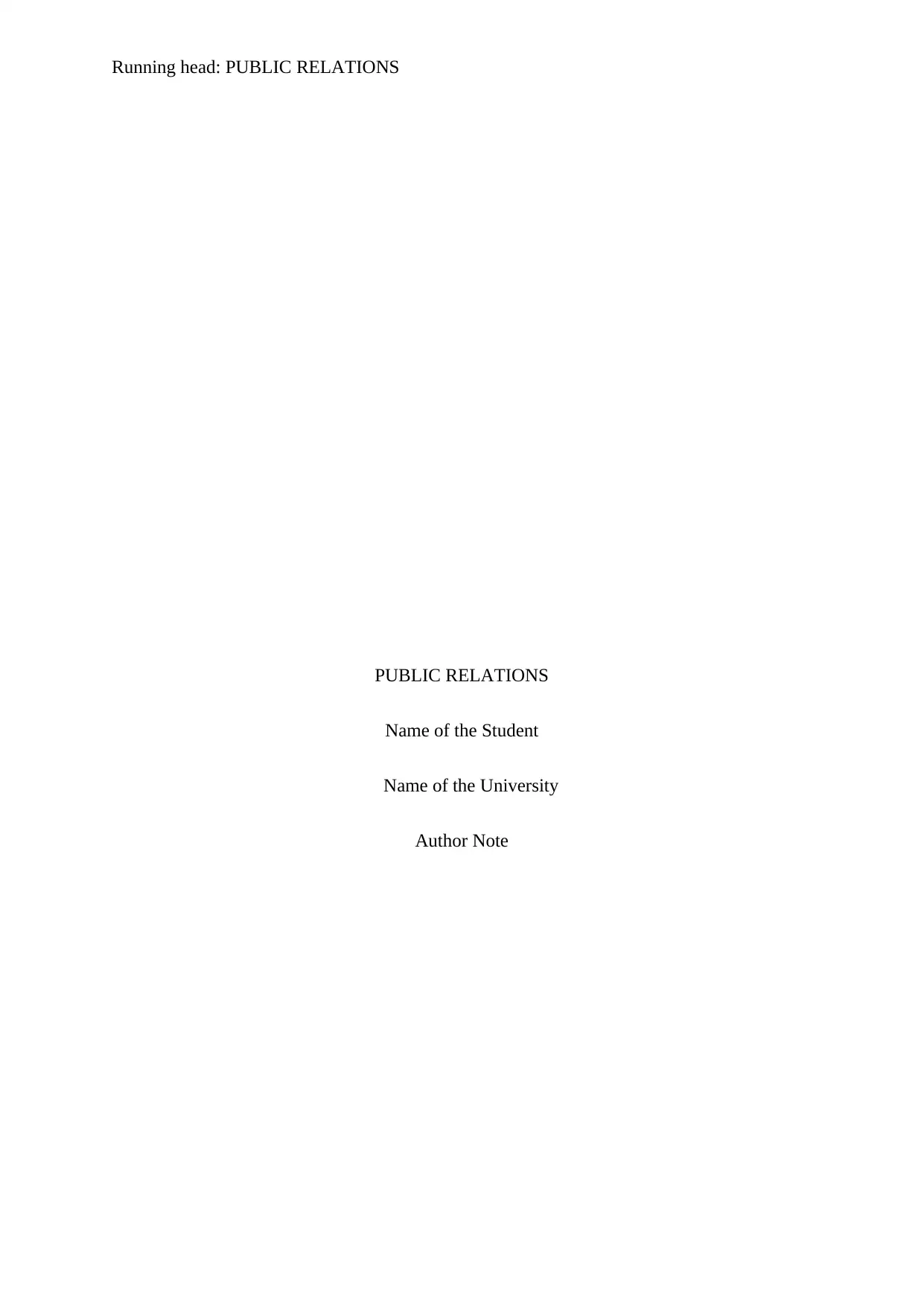
Running head: PUBLIC RELATIONS
PUBLIC RELATIONS
Name of the Student
Name of the University
Author Note
PUBLIC RELATIONS
Name of the Student
Name of the University
Author Note
Secure Best Marks with AI Grader
Need help grading? Try our AI Grader for instant feedback on your assignments.

1PUBLIC RELATIONS
CSR or Corporate Social Responsibility can be defined as the initiatives adopted by
businesses for building a sustainable development of the organization or the environment in
which it is operating through the delivery of social, environmental and economic benefits to
all the stakeholders associated to the operation and effects (Chandler 2016). The main
purpose of Corporate Social Responsibility is to ensure the ethical structure of the businesses.
The activities aims at responding to the impacts of the business actions adopted for operating
in an environment (Crane, Matten and Spence 2019). The benefits of Corporate Social
Responsibility for businesses includes brand recognition, positive reputation, organizational
growth, positive financial condition, increased loyalty and reducing the regulatory burden
(Crane, Matten and Spence 2019). The purpose of the paper is to reflect the demonstration of
Corporate Social Responsibility activities by selecting a private sector organization. The
organization selected for this paper is Uber, Australia. The paper will also evaluate the
manner in which the selected organization have involved stakeholders for facilitating the
initiatives. The paper will be concluded by presenting a summary of the Corporate Social
Responsibility actions and responsibilities.
Headquarter of Uber Technologies Inc. is located in California, San Francisco. The
Transport Network Company is known for offering services like ride services, bicycle-
sharing services, peer-to-peer ridesharing services and food services. Uber is operating in
around 785 metropolitan areas across the globe as well as the services can be facilitated
through the website and its mobile app. The change in the industry due to its impact on the
sharing economy is termed as ‘Uberisation’. The core value of uber also includes the actions
for building future by the help of an active and shared mobility system as well as the ability
to have a cleaner operation in cities. The various strategical actions includes the ridesharing
initiative, which can help the step towards hybrid cars, for the purpose of reducing carbon
emission. The Uber Pool concept was introduced for responding to the increasing concern of
pollution in the presence of personal car service (Crowther and Seifi 2018). Pooling makes
CSR or Corporate Social Responsibility can be defined as the initiatives adopted by
businesses for building a sustainable development of the organization or the environment in
which it is operating through the delivery of social, environmental and economic benefits to
all the stakeholders associated to the operation and effects (Chandler 2016). The main
purpose of Corporate Social Responsibility is to ensure the ethical structure of the businesses.
The activities aims at responding to the impacts of the business actions adopted for operating
in an environment (Crane, Matten and Spence 2019). The benefits of Corporate Social
Responsibility for businesses includes brand recognition, positive reputation, organizational
growth, positive financial condition, increased loyalty and reducing the regulatory burden
(Crane, Matten and Spence 2019). The purpose of the paper is to reflect the demonstration of
Corporate Social Responsibility activities by selecting a private sector organization. The
organization selected for this paper is Uber, Australia. The paper will also evaluate the
manner in which the selected organization have involved stakeholders for facilitating the
initiatives. The paper will be concluded by presenting a summary of the Corporate Social
Responsibility actions and responsibilities.
Headquarter of Uber Technologies Inc. is located in California, San Francisco. The
Transport Network Company is known for offering services like ride services, bicycle-
sharing services, peer-to-peer ridesharing services and food services. Uber is operating in
around 785 metropolitan areas across the globe as well as the services can be facilitated
through the website and its mobile app. The change in the industry due to its impact on the
sharing economy is termed as ‘Uberisation’. The core value of uber also includes the actions
for building future by the help of an active and shared mobility system as well as the ability
to have a cleaner operation in cities. The various strategical actions includes the ridesharing
initiative, which can help the step towards hybrid cars, for the purpose of reducing carbon
emission. The Uber Pool concept was introduced for responding to the increasing concern of
pollution in the presence of personal car service (Crowther and Seifi 2018). Pooling makes
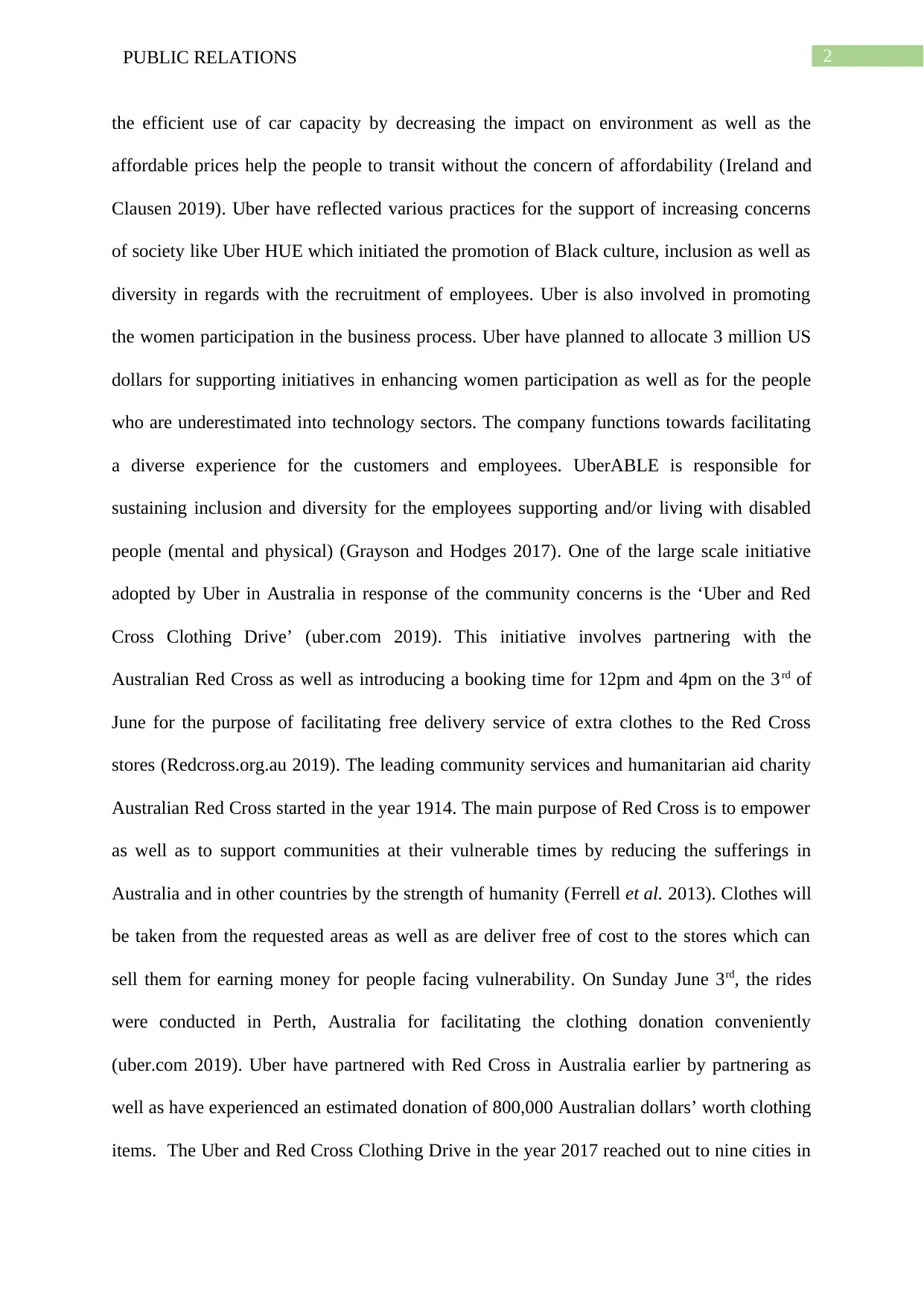
2PUBLIC RELATIONS
the efficient use of car capacity by decreasing the impact on environment as well as the
affordable prices help the people to transit without the concern of affordability (Ireland and
Clausen 2019). Uber have reflected various practices for the support of increasing concerns
of society like Uber HUE which initiated the promotion of Black culture, inclusion as well as
diversity in regards with the recruitment of employees. Uber is also involved in promoting
the women participation in the business process. Uber have planned to allocate 3 million US
dollars for supporting initiatives in enhancing women participation as well as for the people
who are underestimated into technology sectors. The company functions towards facilitating
a diverse experience for the customers and employees. UberABLE is responsible for
sustaining inclusion and diversity for the employees supporting and/or living with disabled
people (mental and physical) (Grayson and Hodges 2017). One of the large scale initiative
adopted by Uber in Australia in response of the community concerns is the ‘Uber and Red
Cross Clothing Drive’ (uber.com 2019). This initiative involves partnering with the
Australian Red Cross as well as introducing a booking time for 12pm and 4pm on the 3rd of
June for the purpose of facilitating free delivery service of extra clothes to the Red Cross
stores (Redcross.org.au 2019). The leading community services and humanitarian aid charity
Australian Red Cross started in the year 1914. The main purpose of Red Cross is to empower
as well as to support communities at their vulnerable times by reducing the sufferings in
Australia and in other countries by the strength of humanity (Ferrell et al. 2013). Clothes will
be taken from the requested areas as well as are deliver free of cost to the stores which can
sell them for earning money for people facing vulnerability. On Sunday June 3rd, the rides
were conducted in Perth, Australia for facilitating the clothing donation conveniently
(uber.com 2019). Uber have partnered with Red Cross in Australia earlier by partnering as
well as have experienced an estimated donation of 800,000 Australian dollars’ worth clothing
items. The Uber and Red Cross Clothing Drive in the year 2017 reached out to nine cities in
the efficient use of car capacity by decreasing the impact on environment as well as the
affordable prices help the people to transit without the concern of affordability (Ireland and
Clausen 2019). Uber have reflected various practices for the support of increasing concerns
of society like Uber HUE which initiated the promotion of Black culture, inclusion as well as
diversity in regards with the recruitment of employees. Uber is also involved in promoting
the women participation in the business process. Uber have planned to allocate 3 million US
dollars for supporting initiatives in enhancing women participation as well as for the people
who are underestimated into technology sectors. The company functions towards facilitating
a diverse experience for the customers and employees. UberABLE is responsible for
sustaining inclusion and diversity for the employees supporting and/or living with disabled
people (mental and physical) (Grayson and Hodges 2017). One of the large scale initiative
adopted by Uber in Australia in response of the community concerns is the ‘Uber and Red
Cross Clothing Drive’ (uber.com 2019). This initiative involves partnering with the
Australian Red Cross as well as introducing a booking time for 12pm and 4pm on the 3rd of
June for the purpose of facilitating free delivery service of extra clothes to the Red Cross
stores (Redcross.org.au 2019). The leading community services and humanitarian aid charity
Australian Red Cross started in the year 1914. The main purpose of Red Cross is to empower
as well as to support communities at their vulnerable times by reducing the sufferings in
Australia and in other countries by the strength of humanity (Ferrell et al. 2013). Clothes will
be taken from the requested areas as well as are deliver free of cost to the stores which can
sell them for earning money for people facing vulnerability. On Sunday June 3rd, the rides
were conducted in Perth, Australia for facilitating the clothing donation conveniently
(uber.com 2019). Uber have partnered with Red Cross in Australia earlier by partnering as
well as have experienced an estimated donation of 800,000 Australian dollars’ worth clothing
items. The Uber and Red Cross Clothing Drive in the year 2017 reached out to nine cities in

3PUBLIC RELATIONS
Australia as a response for bookings for donation. In 2017, the 2500 pickups of Uber rides
collected clothing items of around 41,000 kilograms (uber.com 2019).
The Corporate Social Responsibility activities of Uber like the partnership with
Australian Red Cross was demonstrated as well as planned by forming a strategic map of
promoting the concept. The company facilitated the activities for donation by introducing the
option of ‘Red Cross Clothing Drive card’ in the mobile app and website. The company
accepted the bookings of rides on the third of June for accepting clothing items as well as for
delivering the donated items free of cost to the Red Cross stores. For boosting the
participation, Uber organized a ‘farewell fashion show’, which was hosted and collaborated
by Jackie O by featuring well known personalities walking by wearing clothing items, which
is to be donated to the Red Cross. Uber also offered the opportunity of attaining the fashion
show by initiating a social media campaign, which asked the users to upload a picture in
Instagram of wearing the outfit that is to be donated with the hashtags, like #FarewellFashion,
@redcrossau and @uber_australia before 30th of May 12 pm an after selecting the ten
winners, they will be invited for the ‘farewell fashion show’. The donation only included
clothing items, accessories and shoes, not other household items. The items needed to be
brought near the booked ride for facilitating the delivery process as well as it was advised to
donate items with intact quality and usability (Neubauer 2015). The one touch in the Uber
app presented the option of donating clothes from being at home. The donations were
planned to reach the Australian Red Cross for the purpose of supporting community members
with vulnerability. The merchandise operations manager in Australian Red Cross stated that
“Thanks to the generosity of thousands of Aussies who donate their quality pre-loved fashion,
proceeds from our op shops go towards our vital services helping people overcome crisis at
home and further afield” (uber.com 2019). The other activities of Uber includes the initiative
to promote breast cancer patient care practices. Uber partnered with McGrath Foundation for
supporting the precious work of McGrath nurses for breast cancer. The nurses are placed for
Australia as a response for bookings for donation. In 2017, the 2500 pickups of Uber rides
collected clothing items of around 41,000 kilograms (uber.com 2019).
The Corporate Social Responsibility activities of Uber like the partnership with
Australian Red Cross was demonstrated as well as planned by forming a strategic map of
promoting the concept. The company facilitated the activities for donation by introducing the
option of ‘Red Cross Clothing Drive card’ in the mobile app and website. The company
accepted the bookings of rides on the third of June for accepting clothing items as well as for
delivering the donated items free of cost to the Red Cross stores. For boosting the
participation, Uber organized a ‘farewell fashion show’, which was hosted and collaborated
by Jackie O by featuring well known personalities walking by wearing clothing items, which
is to be donated to the Red Cross. Uber also offered the opportunity of attaining the fashion
show by initiating a social media campaign, which asked the users to upload a picture in
Instagram of wearing the outfit that is to be donated with the hashtags, like #FarewellFashion,
@redcrossau and @uber_australia before 30th of May 12 pm an after selecting the ten
winners, they will be invited for the ‘farewell fashion show’. The donation only included
clothing items, accessories and shoes, not other household items. The items needed to be
brought near the booked ride for facilitating the delivery process as well as it was advised to
donate items with intact quality and usability (Neubauer 2015). The one touch in the Uber
app presented the option of donating clothes from being at home. The donations were
planned to reach the Australian Red Cross for the purpose of supporting community members
with vulnerability. The merchandise operations manager in Australian Red Cross stated that
“Thanks to the generosity of thousands of Aussies who donate their quality pre-loved fashion,
proceeds from our op shops go towards our vital services helping people overcome crisis at
home and further afield” (uber.com 2019). The other activities of Uber includes the initiative
to promote breast cancer patient care practices. Uber partnered with McGrath Foundation for
supporting the precious work of McGrath nurses for breast cancer. The nurses are placed for
Secure Best Marks with AI Grader
Need help grading? Try our AI Grader for instant feedback on your assignments.
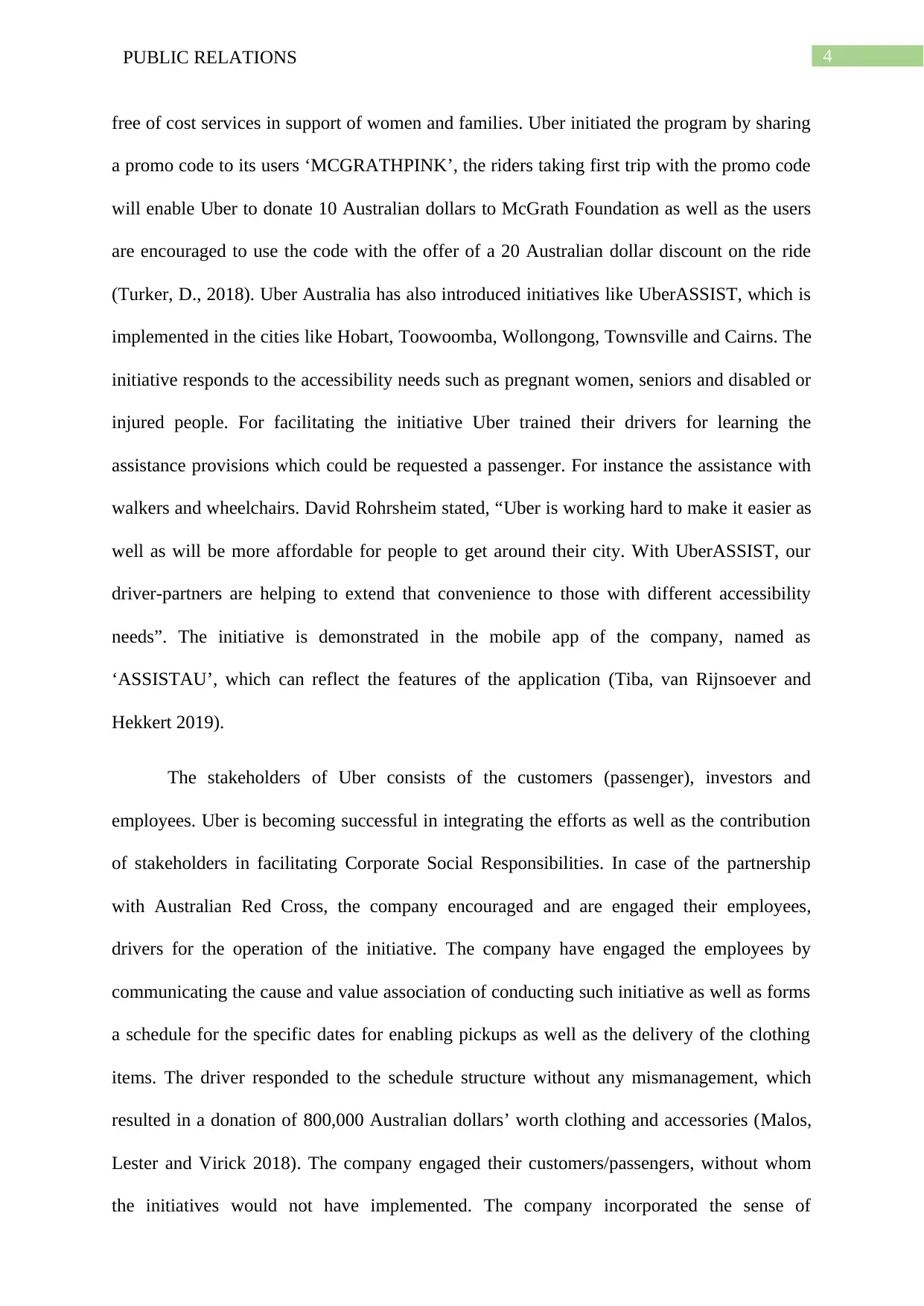
4PUBLIC RELATIONS
free of cost services in support of women and families. Uber initiated the program by sharing
a promo code to its users ‘MCGRATHPINK’, the riders taking first trip with the promo code
will enable Uber to donate 10 Australian dollars to McGrath Foundation as well as the users
are encouraged to use the code with the offer of a 20 Australian dollar discount on the ride
(Turker, D., 2018). Uber Australia has also introduced initiatives like UberASSIST, which is
implemented in the cities like Hobart, Toowoomba, Wollongong, Townsville and Cairns. The
initiative responds to the accessibility needs such as pregnant women, seniors and disabled or
injured people. For facilitating the initiative Uber trained their drivers for learning the
assistance provisions which could be requested a passenger. For instance the assistance with
walkers and wheelchairs. David Rohrsheim stated, “Uber is working hard to make it easier as
well as will be more affordable for people to get around their city. With UberASSIST, our
driver-partners are helping to extend that convenience to those with different accessibility
needs”. The initiative is demonstrated in the mobile app of the company, named as
‘ASSISTAU’, which can reflect the features of the application (Tiba, van Rijnsoever and
Hekkert 2019).
The stakeholders of Uber consists of the customers (passenger), investors and
employees. Uber is becoming successful in integrating the efforts as well as the contribution
of stakeholders in facilitating Corporate Social Responsibilities. In case of the partnership
with Australian Red Cross, the company encouraged and are engaged their employees,
drivers for the operation of the initiative. The company have engaged the employees by
communicating the cause and value association of conducting such initiative as well as forms
a schedule for the specific dates for enabling pickups as well as the delivery of the clothing
items. The driver responded to the schedule structure without any mismanagement, which
resulted in a donation of 800,000 Australian dollars’ worth clothing and accessories (Malos,
Lester and Virick 2018). The company engaged their customers/passengers, without whom
the initiatives would not have implemented. The company incorporated the sense of
free of cost services in support of women and families. Uber initiated the program by sharing
a promo code to its users ‘MCGRATHPINK’, the riders taking first trip with the promo code
will enable Uber to donate 10 Australian dollars to McGrath Foundation as well as the users
are encouraged to use the code with the offer of a 20 Australian dollar discount on the ride
(Turker, D., 2018). Uber Australia has also introduced initiatives like UberASSIST, which is
implemented in the cities like Hobart, Toowoomba, Wollongong, Townsville and Cairns. The
initiative responds to the accessibility needs such as pregnant women, seniors and disabled or
injured people. For facilitating the initiative Uber trained their drivers for learning the
assistance provisions which could be requested a passenger. For instance the assistance with
walkers and wheelchairs. David Rohrsheim stated, “Uber is working hard to make it easier as
well as will be more affordable for people to get around their city. With UberASSIST, our
driver-partners are helping to extend that convenience to those with different accessibility
needs”. The initiative is demonstrated in the mobile app of the company, named as
‘ASSISTAU’, which can reflect the features of the application (Tiba, van Rijnsoever and
Hekkert 2019).
The stakeholders of Uber consists of the customers (passenger), investors and
employees. Uber is becoming successful in integrating the efforts as well as the contribution
of stakeholders in facilitating Corporate Social Responsibilities. In case of the partnership
with Australian Red Cross, the company encouraged and are engaged their employees,
drivers for the operation of the initiative. The company have engaged the employees by
communicating the cause and value association of conducting such initiative as well as forms
a schedule for the specific dates for enabling pickups as well as the delivery of the clothing
items. The driver responded to the schedule structure without any mismanagement, which
resulted in a donation of 800,000 Australian dollars’ worth clothing and accessories (Malos,
Lester and Virick 2018). The company engaged their customers/passengers, without whom
the initiatives would not have implemented. The company incorporated the sense of

5PUBLIC RELATIONS
achievement among the customers as they were getting their pre-loved clothes donated to
Red Cross without the hassle of physical delivery. Uber promotes for these initiatives heavily
by conducting fashion shows and events. The Corporate Social Responsibility initiatives are
basically implemented/operated with the help of the contribution and efforts from the
customers, employees and supporting bodies. In the case of the contribution to McGrath
Foundation, Uber engaged their passengers for the purpose of selecting the promo code of
‘MCGRATHPINK’, which will indicate the processing of contribution initiative as 10 dollars
is contributed for the first ride of the passengers using the promo code, they are encouraged
by imbibing the feeling of achievement of helping the nurses of breast cancer care as well as
they receive a 20 dollars discount on that first ride (Hwang 2019). In case of the uberAssist
initiative, the stakeholders (drivers) are engaged in the process of implementation of the
initiative by the incorporation of training programs. Drivers are trained for offering the
assistance required in by people with disability, old age and pregnancy (Uber.com 2019). The
employees develop a sense of responsibility for helping the people with accessibility needs,
thereby developing the factors of humanity (Doorley and Garcia 2015). Uber also engages the
other set of stakeholders, car partners in this initiative for sourcing resources, a specific size
car for keeping necessary equipment like wheel chair. Even for a simple initiative of starting
a Pooling service, which allows the company to minimize the effects of operational activities
on environment (Uber.com 2019). The company heavily promoted the facility and benefits of
UberPool among the stakeholders, the employee/driver engagement is encouraged by
depicting the benefits of covering multiple rides of a specific area at once as well as engaging
the passengers by reflecting the benefits of affordability factors (Waldman, Verga and
Godsoe 2016). The investors are involved by depicting the positive effects due to the Pool
service as it will require less number of cars for multiple passengers. Uber developed the
Corporate Social Responsibility by adopting initiatives, which needs the support as well as
achievement among the customers as they were getting their pre-loved clothes donated to
Red Cross without the hassle of physical delivery. Uber promotes for these initiatives heavily
by conducting fashion shows and events. The Corporate Social Responsibility initiatives are
basically implemented/operated with the help of the contribution and efforts from the
customers, employees and supporting bodies. In the case of the contribution to McGrath
Foundation, Uber engaged their passengers for the purpose of selecting the promo code of
‘MCGRATHPINK’, which will indicate the processing of contribution initiative as 10 dollars
is contributed for the first ride of the passengers using the promo code, they are encouraged
by imbibing the feeling of achievement of helping the nurses of breast cancer care as well as
they receive a 20 dollars discount on that first ride (Hwang 2019). In case of the uberAssist
initiative, the stakeholders (drivers) are engaged in the process of implementation of the
initiative by the incorporation of training programs. Drivers are trained for offering the
assistance required in by people with disability, old age and pregnancy (Uber.com 2019). The
employees develop a sense of responsibility for helping the people with accessibility needs,
thereby developing the factors of humanity (Doorley and Garcia 2015). Uber also engages the
other set of stakeholders, car partners in this initiative for sourcing resources, a specific size
car for keeping necessary equipment like wheel chair. Even for a simple initiative of starting
a Pooling service, which allows the company to minimize the effects of operational activities
on environment (Uber.com 2019). The company heavily promoted the facility and benefits of
UberPool among the stakeholders, the employee/driver engagement is encouraged by
depicting the benefits of covering multiple rides of a specific area at once as well as engaging
the passengers by reflecting the benefits of affordability factors (Waldman, Verga and
Godsoe 2016). The investors are involved by depicting the positive effects due to the Pool
service as it will require less number of cars for multiple passengers. Uber developed the
Corporate Social Responsibility by adopting initiatives, which needs the support as well as
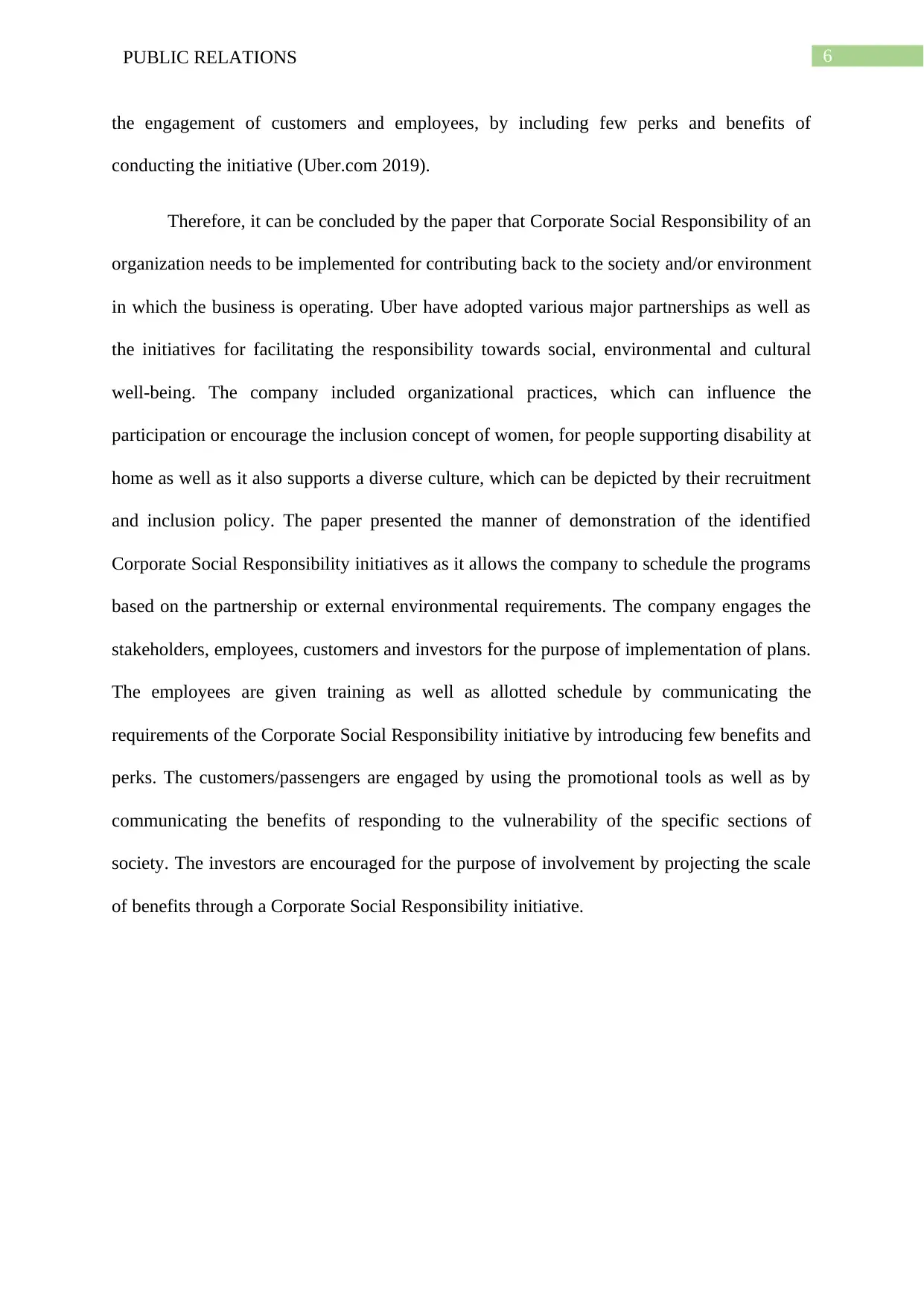
6PUBLIC RELATIONS
the engagement of customers and employees, by including few perks and benefits of
conducting the initiative (Uber.com 2019).
Therefore, it can be concluded by the paper that Corporate Social Responsibility of an
organization needs to be implemented for contributing back to the society and/or environment
in which the business is operating. Uber have adopted various major partnerships as well as
the initiatives for facilitating the responsibility towards social, environmental and cultural
well-being. The company included organizational practices, which can influence the
participation or encourage the inclusion concept of women, for people supporting disability at
home as well as it also supports a diverse culture, which can be depicted by their recruitment
and inclusion policy. The paper presented the manner of demonstration of the identified
Corporate Social Responsibility initiatives as it allows the company to schedule the programs
based on the partnership or external environmental requirements. The company engages the
stakeholders, employees, customers and investors for the purpose of implementation of plans.
The employees are given training as well as allotted schedule by communicating the
requirements of the Corporate Social Responsibility initiative by introducing few benefits and
perks. The customers/passengers are engaged by using the promotional tools as well as by
communicating the benefits of responding to the vulnerability of the specific sections of
society. The investors are encouraged for the purpose of involvement by projecting the scale
of benefits through a Corporate Social Responsibility initiative.
the engagement of customers and employees, by including few perks and benefits of
conducting the initiative (Uber.com 2019).
Therefore, it can be concluded by the paper that Corporate Social Responsibility of an
organization needs to be implemented for contributing back to the society and/or environment
in which the business is operating. Uber have adopted various major partnerships as well as
the initiatives for facilitating the responsibility towards social, environmental and cultural
well-being. The company included organizational practices, which can influence the
participation or encourage the inclusion concept of women, for people supporting disability at
home as well as it also supports a diverse culture, which can be depicted by their recruitment
and inclusion policy. The paper presented the manner of demonstration of the identified
Corporate Social Responsibility initiatives as it allows the company to schedule the programs
based on the partnership or external environmental requirements. The company engages the
stakeholders, employees, customers and investors for the purpose of implementation of plans.
The employees are given training as well as allotted schedule by communicating the
requirements of the Corporate Social Responsibility initiative by introducing few benefits and
perks. The customers/passengers are engaged by using the promotional tools as well as by
communicating the benefits of responding to the vulnerability of the specific sections of
society. The investors are encouraged for the purpose of involvement by projecting the scale
of benefits through a Corporate Social Responsibility initiative.
Paraphrase This Document
Need a fresh take? Get an instant paraphrase of this document with our AI Paraphraser
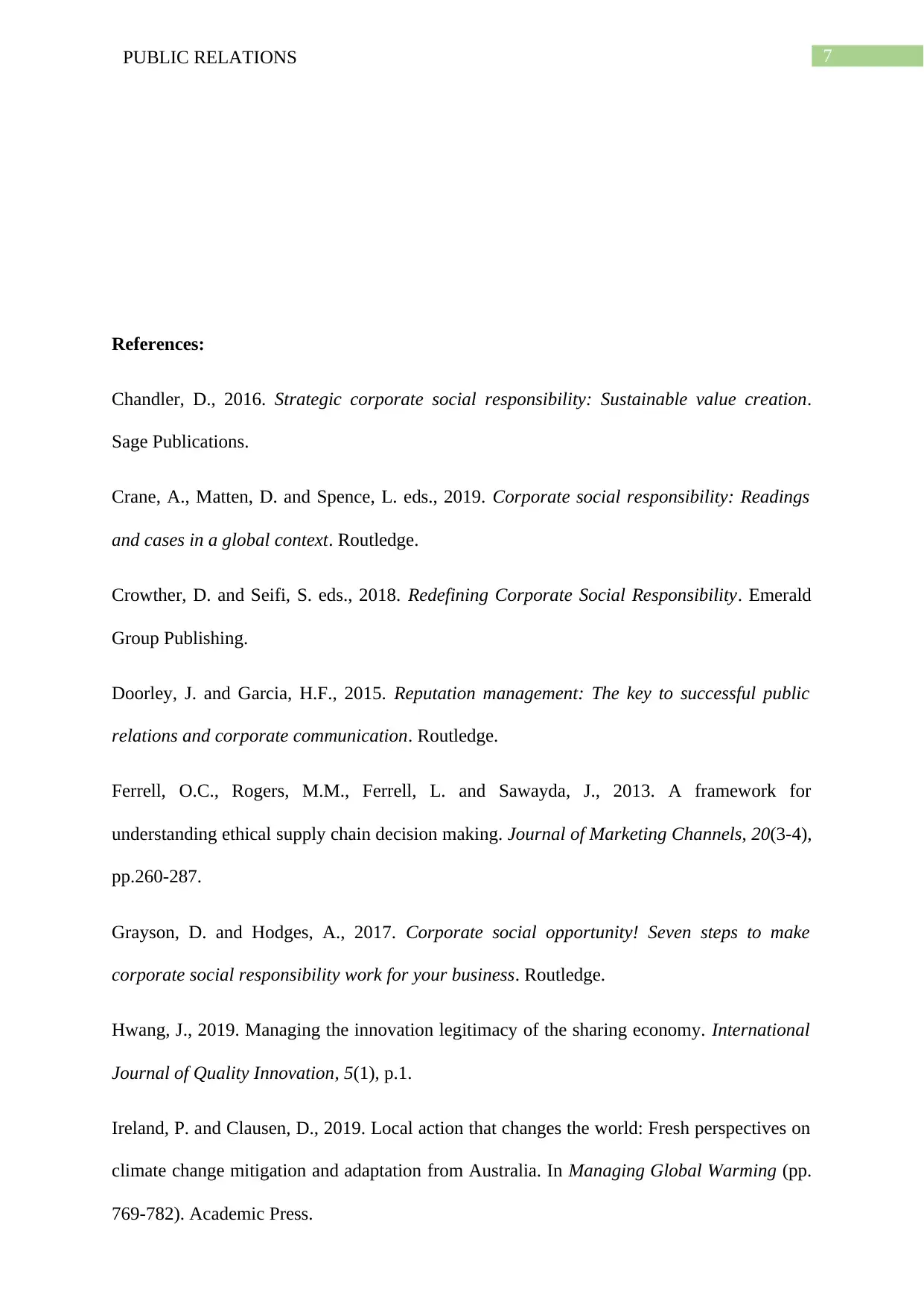
7PUBLIC RELATIONS
References:
Chandler, D., 2016. Strategic corporate social responsibility: Sustainable value creation.
Sage Publications.
Crane, A., Matten, D. and Spence, L. eds., 2019. Corporate social responsibility: Readings
and cases in a global context. Routledge.
Crowther, D. and Seifi, S. eds., 2018. Redefining Corporate Social Responsibility. Emerald
Group Publishing.
Doorley, J. and Garcia, H.F., 2015. Reputation management: The key to successful public
relations and corporate communication. Routledge.
Ferrell, O.C., Rogers, M.M., Ferrell, L. and Sawayda, J., 2013. A framework for
understanding ethical supply chain decision making. Journal of Marketing Channels, 20(3-4),
pp.260-287.
Grayson, D. and Hodges, A., 2017. Corporate social opportunity! Seven steps to make
corporate social responsibility work for your business. Routledge.
Hwang, J., 2019. Managing the innovation legitimacy of the sharing economy. International
Journal of Quality Innovation, 5(1), p.1.
Ireland, P. and Clausen, D., 2019. Local action that changes the world: Fresh perspectives on
climate change mitigation and adaptation from Australia. In Managing Global Warming (pp.
769-782). Academic Press.
References:
Chandler, D., 2016. Strategic corporate social responsibility: Sustainable value creation.
Sage Publications.
Crane, A., Matten, D. and Spence, L. eds., 2019. Corporate social responsibility: Readings
and cases in a global context. Routledge.
Crowther, D. and Seifi, S. eds., 2018. Redefining Corporate Social Responsibility. Emerald
Group Publishing.
Doorley, J. and Garcia, H.F., 2015. Reputation management: The key to successful public
relations and corporate communication. Routledge.
Ferrell, O.C., Rogers, M.M., Ferrell, L. and Sawayda, J., 2013. A framework for
understanding ethical supply chain decision making. Journal of Marketing Channels, 20(3-4),
pp.260-287.
Grayson, D. and Hodges, A., 2017. Corporate social opportunity! Seven steps to make
corporate social responsibility work for your business. Routledge.
Hwang, J., 2019. Managing the innovation legitimacy of the sharing economy. International
Journal of Quality Innovation, 5(1), p.1.
Ireland, P. and Clausen, D., 2019. Local action that changes the world: Fresh perspectives on
climate change mitigation and adaptation from Australia. In Managing Global Warming (pp.
769-782). Academic Press.
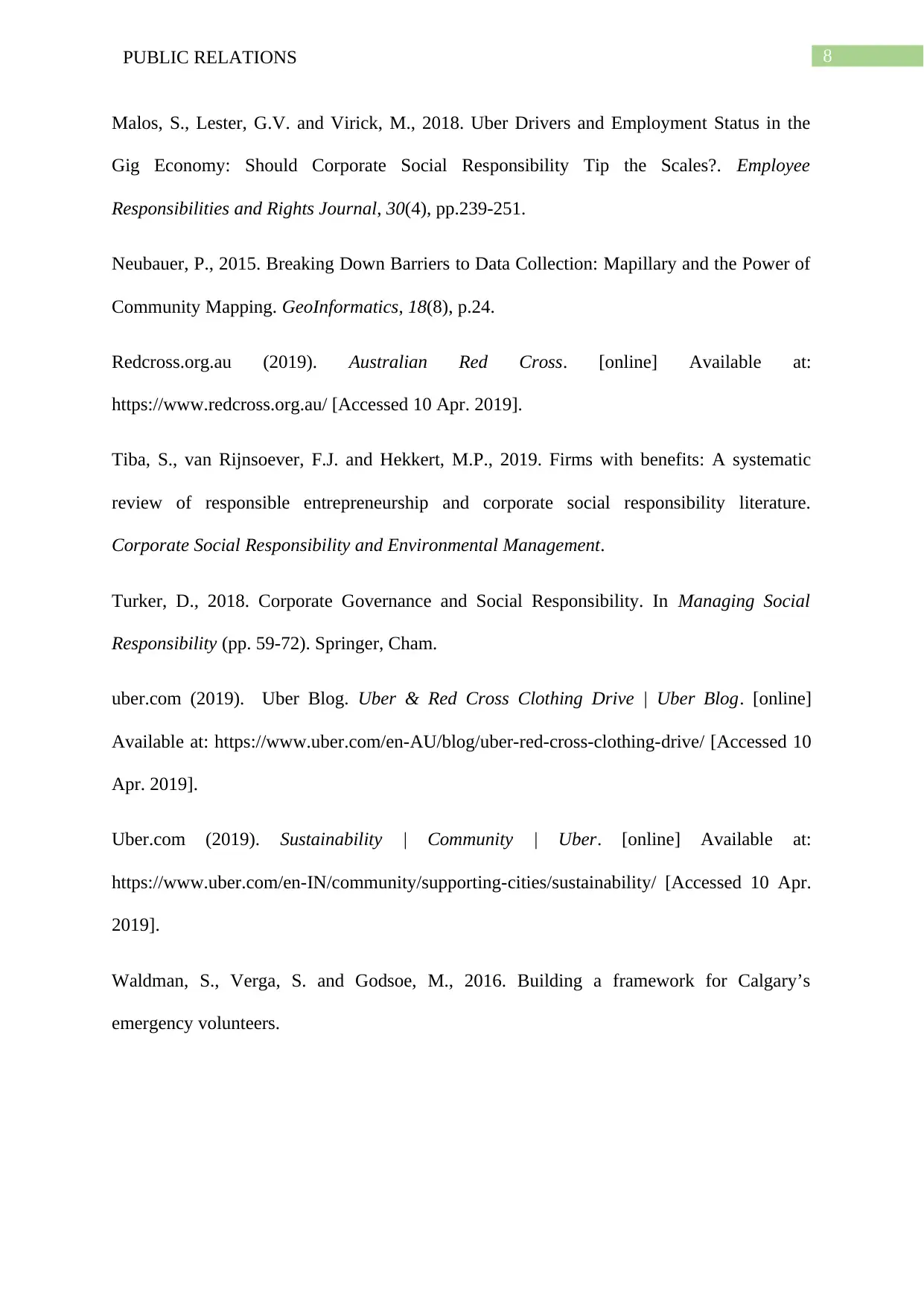
8PUBLIC RELATIONS
Malos, S., Lester, G.V. and Virick, M., 2018. Uber Drivers and Employment Status in the
Gig Economy: Should Corporate Social Responsibility Tip the Scales?. Employee
Responsibilities and Rights Journal, 30(4), pp.239-251.
Neubauer, P., 2015. Breaking Down Barriers to Data Collection: Mapillary and the Power of
Community Mapping. GeoInformatics, 18(8), p.24.
Redcross.org.au (2019). Australian Red Cross. [online] Available at:
https://www.redcross.org.au/ [Accessed 10 Apr. 2019].
Tiba, S., van Rijnsoever, F.J. and Hekkert, M.P., 2019. Firms with benefits: A systematic
review of responsible entrepreneurship and corporate social responsibility literature.
Corporate Social Responsibility and Environmental Management.
Turker, D., 2018. Corporate Governance and Social Responsibility. In Managing Social
Responsibility (pp. 59-72). Springer, Cham.
uber.com (2019). Uber Blog. Uber & Red Cross Clothing Drive | Uber Blog. [online]
Available at: https://www.uber.com/en-AU/blog/uber-red-cross-clothing-drive/ [Accessed 10
Apr. 2019].
Uber.com (2019). Sustainability | Community | Uber. [online] Available at:
https://www.uber.com/en-IN/community/supporting-cities/sustainability/ [Accessed 10 Apr.
2019].
Waldman, S., Verga, S. and Godsoe, M., 2016. Building a framework for Calgary’s
emergency volunteers.
Malos, S., Lester, G.V. and Virick, M., 2018. Uber Drivers and Employment Status in the
Gig Economy: Should Corporate Social Responsibility Tip the Scales?. Employee
Responsibilities and Rights Journal, 30(4), pp.239-251.
Neubauer, P., 2015. Breaking Down Barriers to Data Collection: Mapillary and the Power of
Community Mapping. GeoInformatics, 18(8), p.24.
Redcross.org.au (2019). Australian Red Cross. [online] Available at:
https://www.redcross.org.au/ [Accessed 10 Apr. 2019].
Tiba, S., van Rijnsoever, F.J. and Hekkert, M.P., 2019. Firms with benefits: A systematic
review of responsible entrepreneurship and corporate social responsibility literature.
Corporate Social Responsibility and Environmental Management.
Turker, D., 2018. Corporate Governance and Social Responsibility. In Managing Social
Responsibility (pp. 59-72). Springer, Cham.
uber.com (2019). Uber Blog. Uber & Red Cross Clothing Drive | Uber Blog. [online]
Available at: https://www.uber.com/en-AU/blog/uber-red-cross-clothing-drive/ [Accessed 10
Apr. 2019].
Uber.com (2019). Sustainability | Community | Uber. [online] Available at:
https://www.uber.com/en-IN/community/supporting-cities/sustainability/ [Accessed 10 Apr.
2019].
Waldman, S., Verga, S. and Godsoe, M., 2016. Building a framework for Calgary’s
emergency volunteers.
1 out of 9
Related Documents
Your All-in-One AI-Powered Toolkit for Academic Success.
+13062052269
info@desklib.com
Available 24*7 on WhatsApp / Email
![[object Object]](/_next/static/media/star-bottom.7253800d.svg)
Unlock your academic potential
© 2024 | Zucol Services PVT LTD | All rights reserved.



